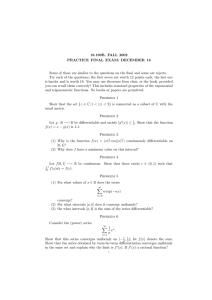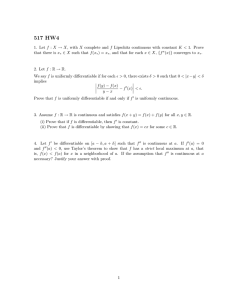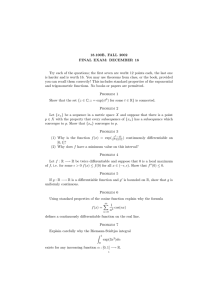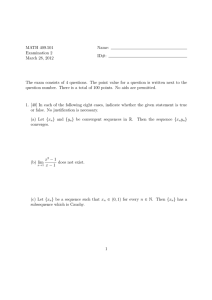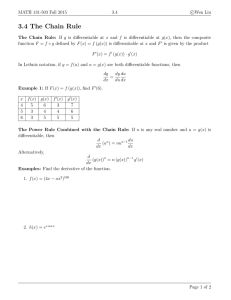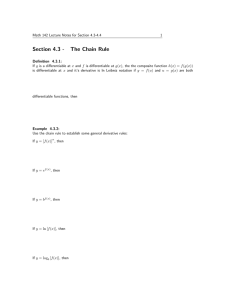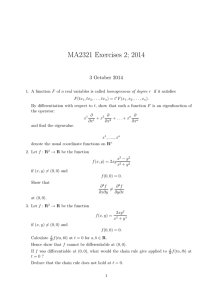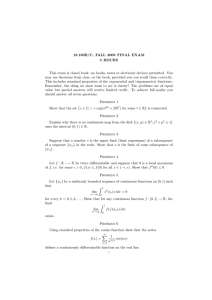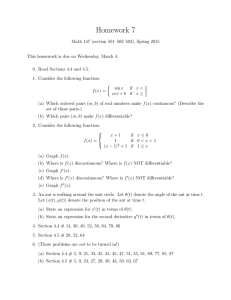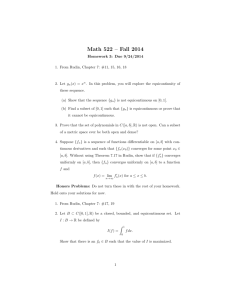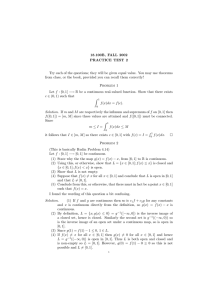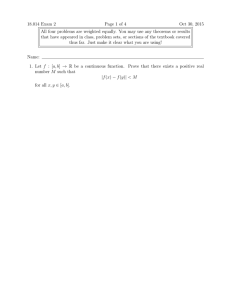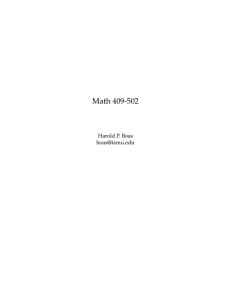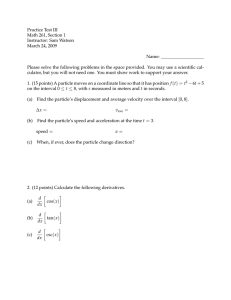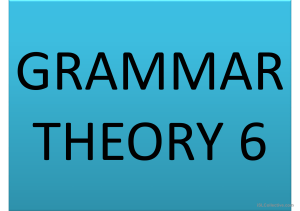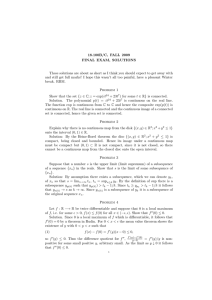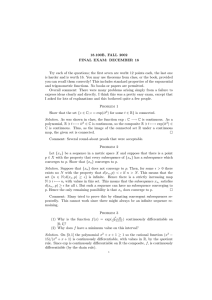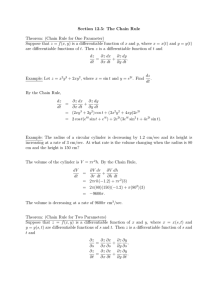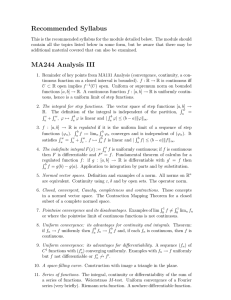18.100B TEST 2 PRACTIVE, 27 APRIL 2004 11:05AM – 12:25PM
advertisement
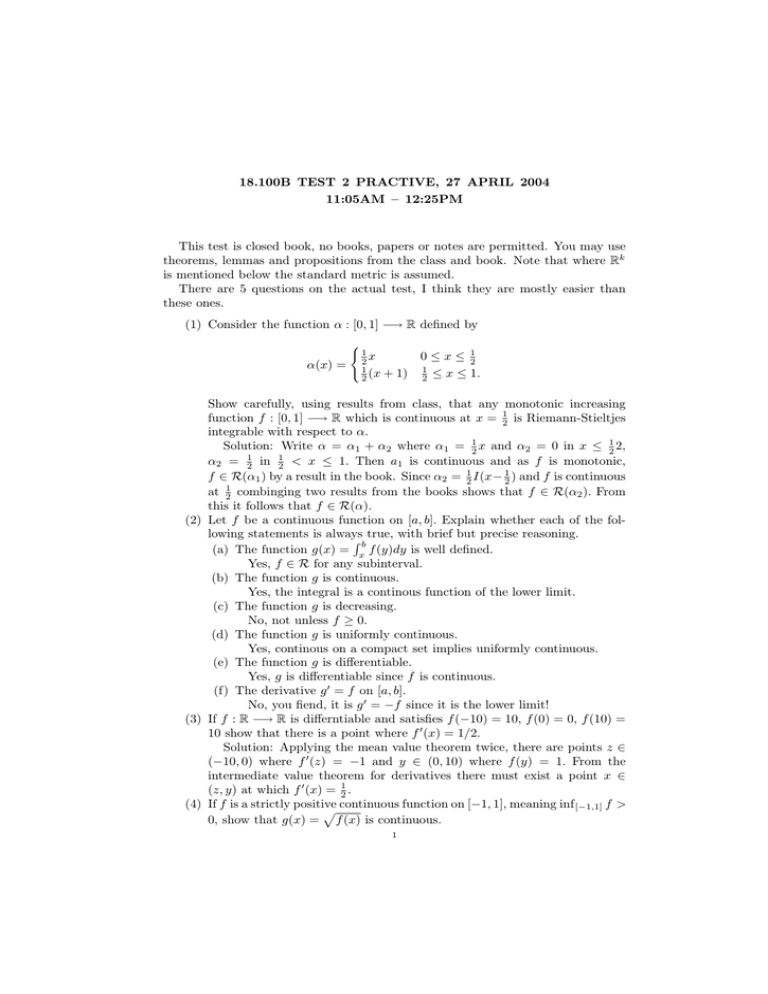
18.100B TEST 2 PRACTIVE, 27 APRIL 2004
11:05AM – 12:25PM
This test is closed book, no books, papers or notes are permitted. You may use
theorems, lemmas and propositions from the class and book. Note that where Rk
is mentioned below the standard metric is assumed.
There are 5 questions on the actual test, I think they are mostly easier than
these ones.
(1) Consider the function α : [0, 1] −→ R defined by
(
α(x) =
1
2x
1
2 (x
0 ≤ x ≤ 12
+ 1) 12 ≤ x ≤ 1.
Show carefully, using results from class, that any monotonic increasing
function f : [0, 1] −→ R which is continuous at x = 21 is Riemann-Stieltjes
integrable with respect to α.
Solution: Write α = α1 + α2 where α1 = 12 x and α2 = 0 in x ≤ 21 2,
α2 = 12 in 12 < x ≤ 1. Then a1 is continuous and as f is monotonic,
f ∈ R(α1 ) by a result in the book. Since α2 = 12 I(x− 12 ) and f is continuous
at 12 combinging two results from the books shows that f ∈ R(α2 ). From
this it follows that f ∈ R(α).
(2) Let f be a continuous function on [a, b]. Explain whether each of the following statements is always true, with brief but precise reasoning.
Rb
(a) The function g(x) = x f (y)dy is well defined.
Yes, f ∈ R for any subinterval.
(b) The function g is continuous.
Yes, the integral is a continous function of the lower limit.
(c) The function g is decreasing.
No, not unless f ≥ 0.
(d) The function g is uniformly continuous.
Yes, continous on a compact set implies uniformly continuous.
(e) The function g is differentiable.
Yes, g is differentiable since f is continuous.
(f) The derivative g 0 = f on [a, b].
No, you fiend, it is g 0 = −f since it is the lower limit!
(3) If f : R −→ R is differntiable and satisfies f (−10) = 10, f (0) = 0, f (10) =
10 show that there is a point where f 0 (x) = 1/2.
Solution: Applying the mean value theorem twice, there are points z ∈
(−10, 0) where f 0 (z) = −1 and y ∈ (0, 10) where f (y) = 1. From the
intermediate value theorem for derivatives there must exist a point x ∈
(z, y) at which f 0 (x) = 21 .
(4) If f is a strictly positive continuous function on [−1, 1], meaning inf [−1,1] f >
p
0, show that g(x) = f (x) is continuous.
1
2
√
Solution: The function :(0, ∞) −→ (0, ∞) is continuous since if x, y >
t > 0, t < 1, then
√
|x − y|
√
| x − y| = √
√ <
x+ y
√
t > t). The composite of two continuous functions is
if |x − y| ≤ t (since
√
continuous so f : [−1, 1] −→ (0, ∞) is continuous.
(5) (This is basically Rudin Problem 4.14)
Let f : [0, 1] −→ [0, 1] be continuous.
(a) State why the the map g(x) = f (x) − x, from [0, 1] to R is continuous.
(b) Using this, or otherwise, show that L = {x ∈ [0, 1]; f (x) ≤ x} is closed
and {x ∈ [0, 1]; f (x) < x} is open.
(c) Show that L is not empty.
(d) Suppose that f (x) 6= x for all x ∈ [0, 1] and conclude that L is open
in [0, 1] and that L 6= [0, 1].
(e) Conclude from this, or otherwise, that there must in fact be a point
x ∈ [0, 1] such that f (x) = x.
(6) Consider the function
f (x) =
−x(x + 1)(x − 100)
x44 + x34 + 1
for x ∈ [0, 100].
(a) Explain why f is differentiable.
(b) Compute f 0 (0).
(c) Show that there exists > 0 such that f (x) > 0 for 0 < x < .
(d) Show that there must exist a point x with f 0 (x) = 0 and 0 < x < 100.
![(1) If f : [0, 1] −→ R is continuous... Z f (x)dx = f (c).](http://s2.studylib.net/store/data/010518093_1-908690675bd939e7f32dbd691b6cbb60-300x300.png)
